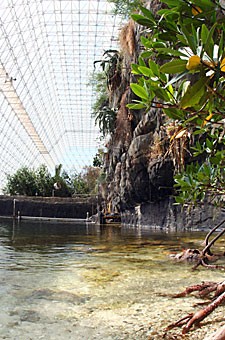Editor’s note: This is the first part in a two-part series detailing developments in the UA’s operation of Biosphere 2.
The UA looks to tackle “”grand challenges”” and inform the public about science on the Biosphere 2 facility whose management and operation the university assumed July 1.
The Biosphere 2 facilities, located in Oracle, are used to conduct research and experimentation on scientific questions in a controlled environment, as well as provide education and outreach to the public about science.
The Biosphere 2 includes B2 Earthscience, which conducts
research, and the B2 Institute, which focuses on an interdisciplinary approach to solving complex scientific issues, said Joaquin Ruiz, dean of the UA College of Science.
“”In the B2 Institute we want to create … a thinktank that deals with the scientific issues we need to address for the 21st century. The ‘grand challenges,’ as they’re known,”” Ruiz said.
The institute aims to contribute to practical solutions to real-world issues, such as water sustainability or energy sources, through interdisciplinary conferences and dialogues, said Pierre Meystre, director of the B2 Institute. The approach would bring together representatives of many disciplines to work on scientific issues.
“”You can certainly not say, ‘Well in five years we will have solved global warming,’ “” Meystre said. “”But it’s certainly all right to say that we are going to … try to make a dent on these problems.””
“”We cannot afford not to look at these problems,”” he added.
A campus spanning 34.5 acres includes a controlled-environment facility, classrooms, conference rooms and a village of 28 residences that can house up to about 300 people, Meystre said.
The campus is being leased to the UA from CDO Ranching & Development, which owns the property, said John Adams, assistant director of facilities planning at Biosphere 2.
The 3.1-acre controlled-environment facility is encased under glass and includes facilities that simulate rainforest, savannah, thorn scrub, desert, marsh and ocean ecosystems, Adams said.
A $30 million contribution from Biosphere 2 facility founder Ed Bass will cover the costs of operations and renovations through the next three, and possibly 10 years, Adams said.
The contribution also will fund research, Ruiz said.
The facility also brings in revenue through the roughly 50,000 visitors who tour the complex each year, Adams said.
There are no extra foreseen costs to the UA to operate or renovate the facility over the next 10 years, Adams said.
Management and use of Biosphere 2 has been complex. Perhaps the most well-known experiment conducted was a study that involved eight people living for two years in the Biosphere 2 dome, Adams said.
Columbia University used the facility from 1996-2003. During that time, It conducted experiments in the dome and constructed the housing units, Adams said.
While the B2 Earthscience branch deals more with research in the facilities, the B2 Institute is more theoretical and will not be heavily involved in experimentation, Meystre said.
Outreach and education are the major components of the future vision behind the Biosphere 2 facility.
“”(The director’s) vision for this place is that oftentimes science is always done behind some gate and it’s 20 miles down the road where no one can get to it,”” Adams said. “”Now we have an opportunity to open up this facility, be able to still conduct the kind of research (directors) want to, but also provide opportunities for the public to be more engaged with what is going on.””
Starting in the summer, the facility will educate K-12 teachers about science, Meystre said.
Biosphere 2 also hopes to highlight research going on at the UA through rotational exhibits on campus, Adams said.
“”We hope to be able to take advantage of the number of people that come through here, the fact that we do have a captive audience, to explain … what is taking place at the U of A and the science that’s ongoing,”” Adams said.









